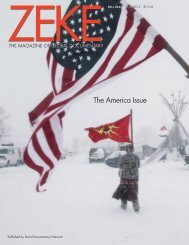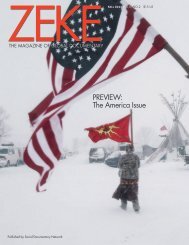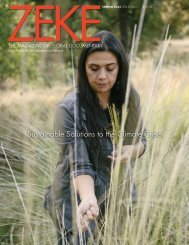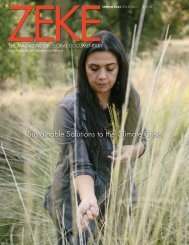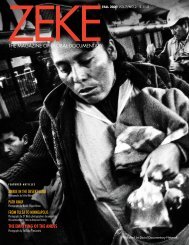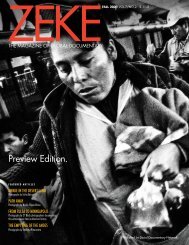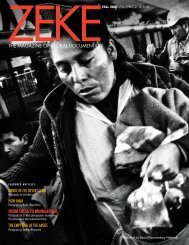ZEKE Magazine: Fall 2021, Interview with Joseph Rodriguez
Joseph Rodriguez is a New York-based photographer whose career spans over 25 years. His work has been published in National Geographic, The New York Times Magazine, Mother Jones, Newsweek, New York Magazine and others. He teaches at NYU and the International Center for Photography (ICP), among others, and has published several books including, more recently: Taxi: A Journey Through My Window 1977-1987 and LAPD 1994. Below is an excerpt from our conversation, edited for clarity.
Joseph Rodriguez is a New York-based photographer whose career spans over 25 years. His work has been published in National Geographic, The New York Times Magazine, Mother Jones, Newsweek, New York Magazine and others. He teaches at NYU and the International Center for Photography (ICP), among others, and has published several books including, more recently: Taxi: A Journey Through My Window 1977-1987 and LAPD 1994. Below is an excerpt from our conversation, edited for clarity.
Create successful ePaper yourself
Turn your PDF publications into a flip-book with our unique Google optimized e-Paper software.
<strong>Interview</strong><br />
JOSEPH RODRIGUEZ<br />
<strong>Joseph</strong> <strong>Rodriguez</strong> is a New York-based photographer<br />
whose career spans over 25 years. His<br />
work has been published in National Geographic,<br />
The New York Times <strong>Magazine</strong>, Mother Jones,<br />
Newsweek, New York <strong>Magazine</strong> and others. He<br />
teaches at NYU and the International Center<br />
for Photography (ICP), among others, and has<br />
published several books including, more recently:<br />
Taxi: A Journey Through My Window 1977-1987<br />
and LAPD 1994. Below is an excerpt from our<br />
conversation, edited for clarity.<br />
By Caterina Clerici<br />
Caterina Clerici: Can you tell us about<br />
your background and how you got<br />
started in photography?<br />
and then dropped out and then got into<br />
the drug scene, started doing heroin,<br />
selling heroin, all that bad boy stuff. I<br />
went to Rikers Island. First time I went in, I<br />
was 17 years old. The second time I was<br />
20, and I was a much tougher guy than<br />
when I first went in. Rikers Island is not<br />
a place that I can even describe to you.<br />
How horrible that place is, that’s a whole<br />
other story.<br />
However, I came out at a very interesting<br />
time because I felt the need to change<br />
and those were the times of affirmative<br />
action, the only way for most young people<br />
to go to college <strong>with</strong>out the ugly bank<br />
loans we have today. Through education<br />
I got myself together: got off methadone<br />
at 26, got my GED and studied graphic<br />
arts technology at the New York City<br />
Technical College in downtown Brooklyn.<br />
In 1980, I came out of school — first one<br />
to go to college in my family — and got<br />
a job in the printing business. You would<br />
send us your chromes, and we would<br />
make negatives, make plates and put<br />
them on a printing press. I learned a lot<br />
about color and printing and that helped<br />
my photography later on.<br />
I was making a lot of money in ‘80,<br />
‘81, doing all those big ads you see<br />
on the front pages of magazines, but I<br />
found myself going back down a rabbit<br />
hole, working 50, 60 hours a week. It<br />
was a great experience, but I was really<br />
unhappy. So I quit my job. My mother<br />
was very upset. I went back to driving<br />
a cab (taking photos that made up Taxi:<br />
Journey Through My Windows 1977-<br />
1987) and worked <strong>with</strong> a friend who had<br />
a truck and an art moving business.<br />
One day we delivered to a gallery in<br />
Soho where Larry Clark was laying his<br />
whole life’s work up on the wall. I went<br />
up to him as if he was Jimi Hendrix, like,<br />
“Oh, man! I really want to do what you<br />
do!” and he said: “Just go make pictures.”<br />
That’s all he said to me.<br />
I went to ICP and started assisting in<br />
the dark room, cleaning up the cibachrome<br />
lab. Then they gave me a scholarship<br />
and my life changed. I was schooled<br />
by some of the greatest Magnum photographers:<br />
Gilles Peress, Susan Meiselas,<br />
Eugene Richards, Alex Webb, Raymond<br />
Depardon, Sebastiao Salgado. The way<br />
I work is the way they work. For weeks,<br />
months and years. Anything personal is<br />
going to take me years. I’m just coming<br />
off following Mexican migrants throughout<br />
the USA for 10 years.<br />
I think about photography in time, and<br />
I always felt great work takes a lot of it.<br />
And, for me, it was always self-initiated.<br />
There were no editors, no one telling me<br />
<strong>Joseph</strong> <strong>Rodriguez</strong>: I was born and<br />
raised in Brooklyn in 1951. I grew up<br />
where I live right now, Park Slope, but it<br />
was South Brooklyn then. And you know,<br />
the Italian American history in New York<br />
was very strong. It was a very mafioso<br />
neighborhood and I’m not lying — we<br />
had the Gowanus Canal and it was not<br />
unusual for us to see floating bodies… It<br />
was pretty much like the old Sicilian way.<br />
In my Catholic school there were<br />
only about 400 or 500 of us. There was<br />
one Black kid and one Puerto Rican kid:<br />
me. The other kids were all mostly from<br />
Genoa, in Italy. Every single parent who<br />
lived close by used to grow grapes in<br />
the backyard and you would stop by to<br />
try their wine. It was very old school.<br />
But then the drugs came, and that’s what<br />
brought a lot of the same problems you<br />
have in so many other places.<br />
I lost my way… got into high school<br />
A young 18th Street Gang member being arrested. At the time this photo was taken the ATF (Arms Tobacco and<br />
Firearms) were working <strong>with</strong> LAPD to try and take down one of the most notorious gangs in Los Angeles. The aim<br />
was also to get as many guns off the streets as possible. Photo by <strong>Joseph</strong> <strong>Rodriguez</strong> from LAPD 1994.<br />
2 / <strong>ZEKE</strong> FALL <strong>2021</strong>









